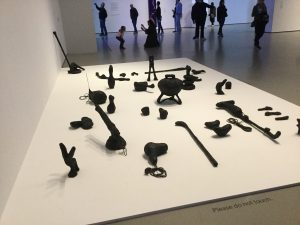
In an era where technology seems to permeate every aspect of our lives, with often terrifying consequences, it seems like we are powerless to control the digital behemoth we have created as if it were some kind of algorithm-powered Frankenstein monster. MoMA’s exhibit New Order: Art and Technology in the Digital Age demonstrates this relationship between the real and digital worlds in ways that I found creative, amusing, and often terrifying. Using a variety of methods including self-run computer animation, sculpture, video, photography, and even film, the art and their artists paint a vivid picture of our current world.
Among my favorite pieces was Skittles by Josh Kline. At first glance, it resembles a simple beverage refrigerator like you’d find at a convenience store—perhaps MoMA added concessions before the exhibit. Look closer, though, and things become less appetizing. Smoothies with questionable—and often inedible—ingredients line the shelves, with each flavor offering a different lifestyle. For example, the Williamsburg flavor is made with bits of credit cards, American Apparel, kale chips, kombucha, microbrew, quinoa, and agave. Yummy. It’s pretty obvious this isn’t real, but if you’re the kind of person who consumes kale chips, kombucha, quinoa, microbrew, and agave while wearing American Apparel, you embody what people imagine when they think of someone who lives in Williamsburg. What you consume is what you are—and here it is, bottled en masse for your convenience.
While I’m on the subject of consumerism, Augmented Objects by Camille Henroit features objects bought on eBay and from street vendors, coated in epoxy, tar, and sand. The results look somewhat similar to their original counterparts and are now unusable. As a result, “Henroit thwarts the normal flow of objects, commodities, and digital networks of exchange.” The black blobs on display look burnt, as if a volcano had just erupted. It’s a chilling metaphor for the futility of our current materialistic lives.
Some of the artists had decidedly less fun with their pieces, including Trevor Paglen with his piece, It Began as a Military Experiment. It presents a series of faces, their features marked with letters around the edges. The images were used by the Department of Defense to compare faces, creating a database of facial recognition that could be used to develop an algorithm that could identify people—which today is on a much larger scale and no longer just part of a private domain. Other pieces were utterly fascinating from a technical level, such as a number of holographic images that I found astounding (though initially a bit hard on the eyes).

The piece I was intrigued by, as well as unsettled by, the most was Xenix by Taylor Robak. Presented on seven screens, the piece depicts what appears to be multiple iterations of an operating system. Graphics depict such trivial tasks as storing food in a refrigerator, scheduling TV shows, chatting, and playing music in the background. One some of the screens though, are guns and a bomb that are initially created in real-time using 3D software. A map often shown in the center of the screen implies sinister military purposes…yet nothing really happens. There are none of the consequences we’d expect from such a setup. At the same time, it shows how much of our lives is carried out on our smartphones and desktops, and perhaps darker things in the future.
In general, I really enjoyed this exhibit, and I liked the ways various artists addressed the roles technology plays in our lives in ways that are unorthodox and ambiguous, but unsettling nonetheless.